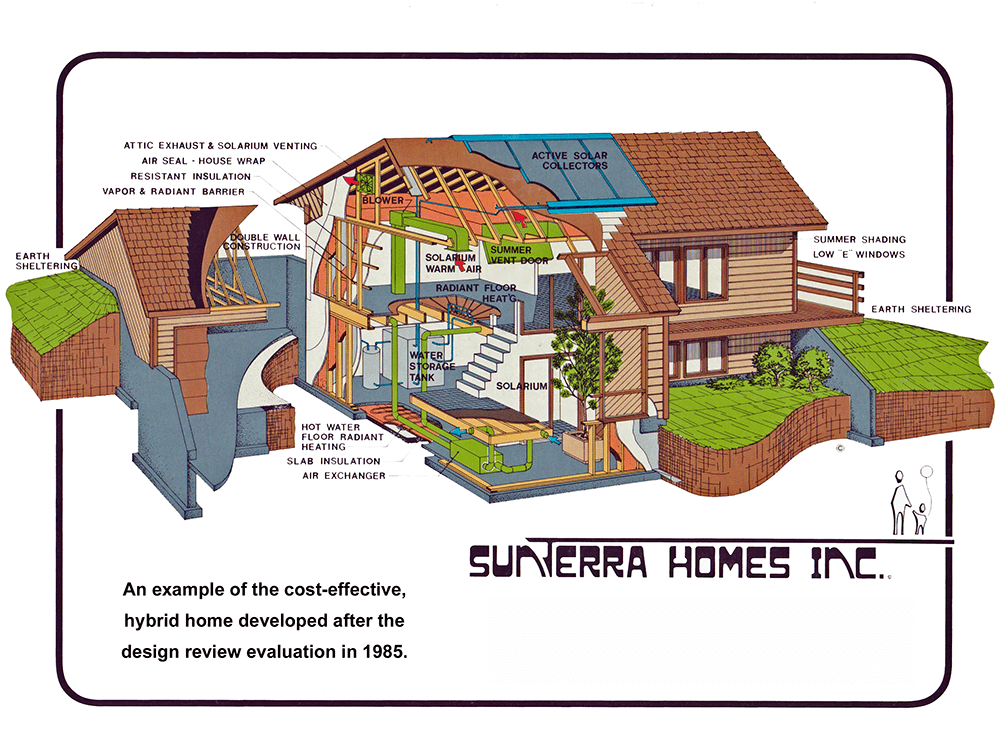SUNTERRA'S HISTORY
The founder of SunTerra Homes, Inc., Jim Chauncey, relocated to Billings, Montana from Portland, Oregon with his family of five in 1974. He brought with him an education in architecture, the title of engineering specialist from Freightliner Corporation, real estate licenses in Oregon and Montana, his general contracting tools, and a desire to design and build energy-efficient, alternative-energy homes. In Billings, Jim started his design and construction business.
1981 MONTANA SOLAR WORKS, INC.
It was this year that Jim Chauncey Design and Construction started a company named Solar Works, Incorporated to provide products for his own construction projects. It soon expanded into a full-blown, alternative-energy heating company providing products and installation services to homeowners and builders throughout Montana and Wyoming.
Solar Works, Inc. developed and manufactured hydronic solar collectors, heat storage controls, and other alternative energy products.
1984 THE BIRTH OF SUNTERRA HOMES, INCORPORATED
During this era of history many designers were motivated to improve home energy efficiency. Some of these included:
Active solar heating
Passive solar heating
Super insulated double walled construction
Sub-terranian construction
Envelope homes
Straw bale homes
Dome homes with panels or urethane shell
Rammed earth homes
Earth ship – used tire construction
At this point, Jim’s real estate background came into play. He evaluated these questions:
What is the best investment for the home consumer?
Will their home appreciate in value?
Will adding an alternative heating system be cost effective?
Will improving the efficiency of the structure save more each year than it costs?
Will the home be more comfortable for the home owner, or less comfortable?
Will the home’s environment be healthier or cause interior pollution issues?
SunTerra looked at all the applied radical solutions in home building and realized the truthful solution was not in employing one concept but rather a balance of several alternative home building methods. Put simply, “A house is a system.”
A conservative active solar system was affordable because of financial benefits received by state and federal tax credits in the mid 1980s.
A passive solar system could be and should be incorporated in home design as long as the heat generated by this system can be distributed and controlled in a way that does not overheat the space, creating discomfort.
Insulation could be increased to the point that the cost of investment would not pass the point of diminishing returns.
Air tight construction with controlled ventilation providing healthy air quality was an essential feature of the system.
Earth sheltering was appropriate if the building site allowed.
The SunTerra home became a cost effective hybrid design providing more value to the home owner.
It was this comprehensive evaluation of energy-efficient construction that gained SunTerra the State of Montana Governor’s Citation for Meritorious Service Award and Energy Innovation Award from the United States Department of Energy in 1986.
SunTerra continued designing and building custom homes for their clients until 1990 when the family and business moved back to Oregon.
The company has remained committed to building energy-efficient homes that surpass client expectations. SunTerra homes continues to lead the industry in green-home building, achieving many local and national awards.




